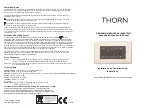
C
HAPTER
4
| Configuring the Switch
Configuring Security
– 94 –
password in the subsequent EAP exchange with the RADIUS server.
The 6-byte MAC address is converted to a string on the following
form “xx-xx-xx-xx-xx-xx”, that is, a dash (-) is used as separator
between the lower-cased hexadecimal digits. The switch only
supports the MD5-Challenge authentication method, so the RADIUS
server must be configured accordingly.
When authentication is complete, the RADIUS server sends a
success or failure indication, which in turn causes the switch to open
up or block traffic for that particular client, using the Port Security
module. Only then will frames from the client be forwarded on the
switch. There are no EAPOL frames involved in this authentication,
and therefore, MAC-based Authentication has nothing to do with the
802.1X standard.
The advantage of MAC-based authentication over port-based
802.1X is that several clients can be connected to the same port
(e.g. through a 3rd party switch or a hub) and still require individual
authentication, and that the clients don't need special supplicant
software to authenticate. The advantage of MAC-based
authentication over 802.1X-based authentication is that the clients
don't need special supplicant software to authenticate. The
disadvantage is that MAC addresses can be spoofed by malicious
users - equipment whose MAC address is a valid RADIUS user can
be used by anyone. Also, only the MD5-Challenge method is
supported. The maximum number of clients that can be attached to
a port can be limited using the Port Security Limit Control
functionality.
Further Guidelines for Port Admin State
■
Port Admin state can only be set to Force-Authorized for ports
participating in the Spanning Tree algorithm (see
page 135
).
■
When 802.1X authentication is enabled on a port, the MAC address
learning function for this interface is disabled, and the addresses
dynamically learned on this port are removed from the common
address table.
■
Authenticated MAC addresses are stored as dynamic entries in the
switch's secure MAC address table. Configured static MAC addresses
are added to the secure address table when seen on a switch port
(see
page 170
). Static addresses are treated as authenticated
without sending a request to a RADIUS server.
■
When port status changes to down, all MAC addresses are cleared
from the secure MAC address table. Static VLAN assignments are
not restored.
◆
RADIUS-Assigned QoS Enabled
- Enables or disables this feature for
a given port. Refer to the description of this feature under the System
Configuration section.
◆
RADIUS-Assigned VLAN Enabled
- Enables or disables this feature
for a given port. Refer to the description of this feature under the
System Configuration section.
Summary of Contents for GEP-5070
Page 1: ...GEP 5070 48 GE PoE Plus 2 GE SFP L2 Managed Switch User Manual V1 0...
Page 2: ......
Page 4: ......
Page 6: ...ABOUT THIS GUIDE 6...
Page 18: ...FIGURES 18...
Page 20: ...TABLES 20...
Page 22: ...SECTION I Getting Started 22...
Page 34: ...SECTION II Web Configuration 34...
Page 217: ...CHAPTER 4 Configuring the Switch Configuring sFlow 217 Figure 96 sFlow Configuration...
Page 218: ...CHAPTER 4 Configuring the Switch Configuring sFlow 218...
Page 286: ...CHAPTER 6 Performing Basic Diagnostics Running Cable Diagnostics 286...
Page 292: ...CHAPTER 7 Performing System Maintenance Managing Configuration Files 292...
Page 294: ...SECTION III Appendices 294...
Page 312: ...GLOSSARY 312...
Page 317: ......
Page 318: ...GEP 5070 E042013 ST R01...
















































